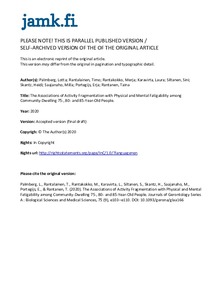The associations of activity fragmentation with physical and mental fatigability among community-dwelling 75-, 80-, and 85-year-old people
Palmberg, Lotta; Rantalainen, Timo; Rantakokko, Merja; Karavirta, Laura; Siltanen, Sini; Skantz, Heidi; Saajanaho, Milla; Portegijs, Erja; Rantanen, Taina (2020)
Palmberg, Lotta
Rantalainen, Timo
Rantakokko, Merja
Karavirta, Laura
Siltanen, Sini
Skantz, Heidi
Saajanaho, Milla
Portegijs, Erja
Rantanen, Taina
Oxford University Press (OUP)
2020
All rights reserved. This publication is copyrighted. You may download, display and print it for Your own personal use. Commercial use is prohibited.
Julkaisun pysyvä osoite on
https://urn.fi/URN:NBN:fi-fe202103127246
https://urn.fi/URN:NBN:fi-fe202103127246
Tiivistelmä
Background Fatigue related to task standardized by duration and intensity, termed fatigability, could manifest as shortening of activity bouts throughout the day causing daily activity to accumulate in a more fragmented pattern. Our purpose was to study the association of activity fragmentation with physical and mental dimensions of fatigability. Methods A cross-sectional study of 485 community-dwelling 75-,80- and 85-year-old people using a thigh-worn accelerometer for 3 to 7 days. Activity fragmentation was studied as Active-to-Sedentary Transition Probability (ASTP) for two operational definitions of physical activity: accelerations equivalent to at least light physical activity, and for upright posture. Physical fatigability was assessed as perceived exertion fatigability, performance fatigability severity, and with the Physical Fatigue Subscale of the Situational Fatigue Scale (SFS). Mental fatigability was assessed with the Mental Fatigue Subscale of the SFS and as a decrease in perceived mental alertness after a six-minute walk test (6MWT). Results Higher activity fragmentation was associated with higher self-reported physical fatigability, perceived exertion fatigability and performance fatigability severity, independent of total activity minutes (β 0.13-0.33, p<0.05 for all). Higher activity fragmentation was not associated with mental fatigability in the fully adjusted models. The associations with fatigability indices were similar for both activity fragmentation indicators. Associations of activity fragmentation and performance fatigability severity were similar also among those with the highest intensity-based physical activity volume. Conclusions The findings provide support that studying fragmented activity patterns can be useful in identifying those at risk for high fatigability, even among those with relatively high physical activity level.
